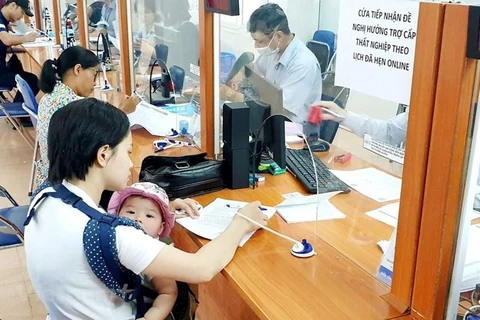Hanoi (VNA) - New research by the International Labour Organization (ILO) highlights the heavy impact of the COVID-19 pandemic on ASEAN economies and looks at possible recovery scenarios.
In none of those scenarios, with mobility restrictions, progress on vaccination and the pace of economy recovery taken into consideration, are working hours projected to fully recover by 2022.
Labour market to deteriorate further in second half
In 2021, ASEAN is expected to see losses in working hours of 7.4 percent in the baseline scenario and 7.0 percent and 7.9 percent in the optimistic and pessimistic scenarios, respectively, compared to pre-pandemic levels.
The region recorded working-hour losses of 6.1 percent in the first quarter of 2021 and 6.2 percent in the second. In the second half of 2021, labour market conditions are expected to deteriorate further due to the ongoing wave of the COVID-19 pandemic.
“The crisis has laid bare the vulnerabilities of the economies and labour markets in the region,” said Chihoko Asada-Miyakawa, ILO’s Assistant Director-General and Regional Director for Asia and the Pacific.
“With the situation likely to persist for some time, the urgency grows for ASEAN countries to accelerate the policies and programmes that will boost the resilience of enterprises, workers and households and set stronger foundations for decent work for all.”
The brief highlights that in 2020, there were 10.6 million fewer workers in employment in the region than what would have been expected in the absence of the pandemic. The region recorded working-hour losses of 8.4 percent in 2020, equivalent to the working time of about 24 million full-time workers, while labour income fell by 7.8 percent.
The Philippines saw the largest working-hour losses among the ASEAN countries in 2020 with an annual decrease of 13.6 percent. In contrast, working hours in countries like Brunei, Laos, Thailand and Vietnam saw hours worked drop by below 6 percent. Women and young workers were among the groups most impacted by job losses.
ASEAN economies and labour markets have been impacted through various channels by the pandemic, including lockdown measures implemented by authorities to curb the spread of the virus, the dramatic decline in tourism, the decrease in domestic consumption as well as impacts through global supply chains.
According to the brief, ASEAN countries have collectively allocated nearly 16 percent of GDP on the fiscal stimulus response as of the end of May 2021. However, further policy action in the realm of social protection, enterprise support and labour protections will be needed to ensure a human-centred recovery from the crisis in the ASEAN region.
40 million labourers impacted in pessimistic scenario
In its report, the Labour Department under the Ministry of Labour, Invalids and Social Affairs has also put forth three scenarios for the domestic labour market.
Under the optimistic scenario when COVID-19 is put under control and localities lift the social distancing order in line with Directive No. 16 right in August, more than 22 million labourers would be impacted in the third quarter of this year.
Most of the affected employees are working in such sectors as manufacturing, processing, tourism, lodging services, retail, and arts, which have observed the social distancing order.
Around 500,000-6000,000 labourers will lose their jobs and another 5 million see their working hours reduced. However, businesses are projected to need more than 5 million employees in the third quarter to recover their operation.
Under the baseline scenario when COVID-19 cases continue to surge in both southern and northern localities, the number of pandemic-hit labourers is expected to reach 30 million.
Meanwhile, under the pessimistic scenario when COVID-19 is out of control, nearly 40 million laboures in all sectors would experience the adverse impact of the pandemic.
The department said the pandemic put a freeze on the southern labour market in July, which used to attract the largest number of employees in the country./.

























